
|
The butt-fused joint shall be properly aligned and shall have uniform roll-back beads resulting from the use of proper temperature and pressure. The joint surfaces shall be smooth. The fused joint shall be watertight and shall have tensile strength equal to that of the pipe. All joints shall be subject to acceptance by the Engineer and/or his representative prior to insertion. All defective joints shall be cut out and replaced at no cost to the City. … |
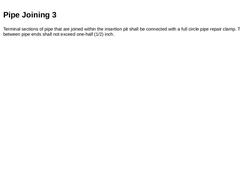
|
Terminal sections of pipe that are joined within the insertion pit shall be connected with a full circle pipe repair clamp. The butt gap between pipe ends shall not exceed one-half (1/2) inch. |
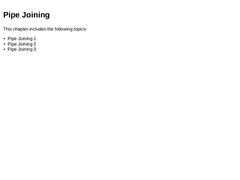
|
|

|
The inserted pipe shall be paid for per linear foot of the size pipe specified and shall include all pipe bedding, backfill material, annulus sealing material and launching pits. Locating and reconstruction of services and all reconnections of services shall be paid for per each connection made, including fittings and pipe. |
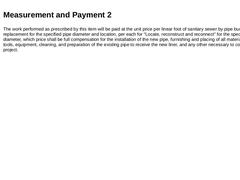
|
The work performed as prescribed by this item will be paid at the unit price per linear foot of sanitary sewer by pipe bursting/replacement for the specified pipe diameter and location, per each for "Locate, reconstruct and reconnect" for the specified pipe diameter, which price shall be full compensation for the installation of the new pipe, furnishing and placing of all materials, labor, tools, equipment, cleaning, and preparation of the existing … |
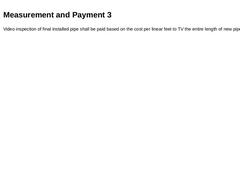
|
Video inspection of final installed pipe shall be paid based on the cost per linear feet to TV the
entire length of new pipe. |
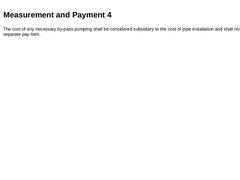
|
The cost of any necessary by-pass pumping shall be considered subsidiary to the cost of pipe installation and shall not be a separate pay item. |
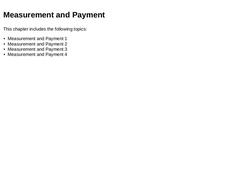
|
|
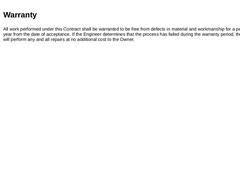
|
All work performed under this Contract shall be warranted to be free from defects in material and workmanship for a period of one year from the date of acceptance. If the Engineer determines that the process has failed during the warranty period, the Contractor will perform any and all repairs at no additional cost to the Owner. |

|
Sample Technical Specifications for the Reconstruction of Sanitary Sewer by the Pipe Bursting/Replacement Process |

|
|

|
(Image: 144394 - Titelbild Dokumentation)Process: Grouted-in-place lining process Title: Renovation of a masonry ovoid cross section DN 2250/1800 using the Trolining® process in the version of the Trolining® double system in modified form (without using a preliner) Promoted by: MUNLV NRW (Ministry for Environment and Nature Protection, Agriculture and Consumer Protection of the German federal state North Rhine-Westphalia) Location: Main road Limiting … |

|
Machines and equipment: For the use of the grouted-in-place lining process, the following machines and devices are primarily required: - 1 fork-lift truck
- 1 capstan winch
- 2 compressors
- 1 turning roller
- 1 unwinding construction
- 2 sealing balloons ovoid cross section DN 2250/1800
- 3 sealing balloons circular cross section DN 100
- 3 mixing units (each consisting of main mixer, steering unit and 2 post mixers)
- 2 extruder welding machine
- 2 angle grinder
- 1 drilling …
|

|
Site equipment Site equipment includes traffic safety, provision and preparation of storage surfaces for equipment and material as well as the provision of power and water supplies. Water supply is secured via a hydrant. Maintaining the drainage capability In this application case, the wastewater is pumped into a parallel overflow collector above the construction section by means of three pumps in order to maintain the drainage capability. For safety … |

|
Starting excavation In the present case, a part of a section with a length of approx. 50 m is rehabilitated using the Trolining-process. Stud hoses of this size are generally pulled in via a manhole (2 x 2 m). As for this construction measure a starting excavation has already been installed for it is required for the whole construction, the stud hoses are pulled in via this starting excavation. For the installation of the starting excavation, the sewer … |

|
In this case, the renovation of a masonry sewer is to be carried out by means of a modification of the Trolining® double system. The Trolining® double system is used in order to increase the static load bearing capacity of the rehabilitated sewer. In this special application case, this process is modified in that it refrains from pulling in a preliner and the stud hoses are directly pulled into the section. Due to the grouting of the external annular … |

|
In order to produce a tight annular space sealing between the old sewer and the outer stud hose, it is necessary to glue a HD-PE-fleece at both ends of a section to be rehabilitated into the sewer due to the different materials (masonry/HD-PE). Unlike the masonry, this can be welded to the outer stud hose. This way a tight annular space sealing is produced for the subsequent grouting of the annular space. Production of the HD-PE-fleece The pieces of … |

|
Both existing laterals must be sealed before the pulling-in of the outer stud hose in order to prevent an uncontrolled elusion of the injector in the range of the inlets during the grouting of the external annular space. This is done by a glued piece of HD-PE-fleece which is welded to the stud hoses when the laterals are later re-connected and which impedes wastewater to enter the external and internal annular space after the sewer has been put into … |

|
Preparatory measures At the target excavation, a diesel-electric capstan winch is prepared for the pulling-in of the stud hoses. (Image: Capstan winch) The stud hoses are pulled from the unwinding construction into the starting excavation via a turning roller. In order to prevent that the hoses unwind too fast, the unwinding construction is equipped with a brake that can be applied or released by hand. | (Image: Construction site situation (left: unwinding … |
|

|
Pulling-in of the outer stud hose At the top of the stud hose, a pulling head is produced by folding. First, the pulling head is lowered into the starting excavation and connected to the winch cable, which was placed from the capstan winch via the target manhole into the part of the section to be rehabilitated. | (Image: View from below to the stud hose during the pulling-in process) | (Image: Pulling-in of the stud hose - view to the pulling head) | (… |
|

|
Installation of the grouting nozzles / Welding of the HD-PE-fleece to the outer stud hose As a first step, nozzles for the grouting and ventilation during the grouting process are installed at both ends of the outer stud hose. For this purpose, the openings are marked, cut out and roughened for the welding process by means of an angle grinder. An extruder welding machine is used for the welding. This is provided with a welding filler in the form of … |

|
Pulling-in of the inner stud hose Before the inner stud hose can be pulled in, the temporary stilts (square timbers) are removed from the outer stud hose. The pulling-in process as well as the unfolding process is analogous to the pulling-in of the outer stud hose. | (Image: Pulling-in of the inner stud hose - view to the pulling head) | (Image: Pulling-in of the inner stud hose - folding the stud hose) | (Image: Pulling-in of the inner stud hose - folding … |
|

|
Fixing of the filling nozzles / Welding of the stud hoses For the grouting of the internal annular space (between the outer and inner stud hose), two filling nozzles - analogous to the procedure for the external annular space - are fixed at both ends of the stud hose and the inner stud hose is welded to the outer one. (Image: Detail View to the filling nozzles for the grouting of the external (1) and internal (2) annular space) On completion of the … |

|
Preparatory measures Because of the short processing time of the TROLINING® injector grout of only approximately 1.5 hours, the grouting of the injector, which is a very large amount in this case, takes place by means of two mixing units. A mixing unit consists of a main mixer for preparing the injector grouting cement with water, a steering unit which regulates the water and power supply to the individual components as well as two post mixers that … |

|
Testing during grouting Sample bottles are used for the sampling to regularly control the Trolining® injector and to document the injection processes. In addition, the following items are required for the evaluation and documentation: - Scales,
- Marsh funnel,
- Stop watch,
- Thermometer,
- Pocket calculator,
- Protocol form.
At intervals of 10-15 min, the following properties of the injector grout material are tested during the whole of the grouting process: |